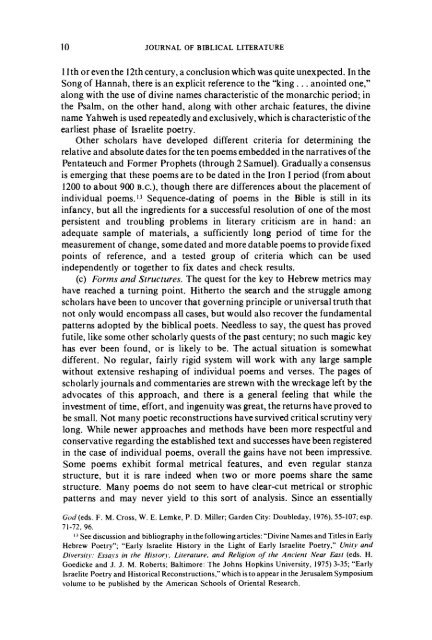POTTERY, POETRY, AND PROPHECY: AN ESSAY ON BIBLICAL ...
POTTERY, POETRY, AND PROPHECY: AN ESSAY ON BIBLICAL ...
POTTERY, POETRY, AND PROPHECY: AN ESSAY ON BIBLICAL ...
Create successful ePaper yourself
Turn your PDF publications into a flip-book with our unique Google optimized e-Paper software.
10<br />
JOURNAL OF <strong>BIBLICAL</strong> LITERATURE<br />
1 1th or even the 12th century, a conclusion which was quite unexpected. In the<br />
Song of Hannah, there is an explicit reference to the "king ... anointed one,"<br />
along with the use of divine names characteristic of the monarchic period; in<br />
the Psalm, on the other hand, along with other archaic features, the divine<br />
name Yahweh is used repeatedly and exclusively, which is characteristic of the<br />
earliest phase of Israelite poetry.<br />
Other scholars have developed different criteria for determining the<br />
relative and absolute dates for the ten poems embedded in the narratives of the<br />
Pentateuch and Former Prophets (through 2 Samuel). Gradually a consensus<br />
is emerging that these poems are to be dated in the Iron I period (from about<br />
1200 to about 900 B.C.), though there are differences about the placement of<br />
individual poems.'3 Sequence-dating of poems in the Bible is still in its<br />
infancy, but all the ingredients for a successful resolution of one of the most<br />
persistent and troubling problems in literary criticism are in hand: an<br />
adequate sample of materials, a sufficiently long period of time for the<br />
measurement of change, some dated and more datable poems to provide fixed<br />
points of reference, and a tested group of criteria which can be used<br />
independently or together to fix dates and check results.<br />
(c) Forms and Structures. The quest for the key to Hebrew metrics may<br />
have reached a turning point. Hitherto the search and the struggle among<br />
scholars have been to uncover that governing principle or universal truth that<br />
not only would encompass all cases, but would also recover the fundamental<br />
patterns adopted by the biblical poets. Needless to say, the quest has proved<br />
futile, like some other scholarly quests of the past century; no such magic key<br />
has ever been found, or is likely to be. The actual situation is somewhat<br />
different. No regular, fairly rigid system will work with any large sample<br />
without extensive reshaping of individual poems and verses. The pages of<br />
scholarly journals and commentaries are strewn with the wreckage left by the<br />
advocates of this approach, and there is a general feeling that while the<br />
investment of time, effort, and ingenuity was great, the returns have proved to<br />
be small. Not many poetic reconstructions have survived critical scrutiny very<br />
long. While newer approaches and methods have been more respectful and<br />
conservative regarding the established text and successes have been registered<br />
in the case of individual poems, overall the gains have not been impressive.<br />
Some poems exhibit formal metrical features, and even regular stanza<br />
structure, but it is rare indeed when two or more poems share the same<br />
structure. Many poems do not seem to have clear-cut metrical or strophic<br />
patterns and may never yield to this sort of analysis. Since an essentially<br />
God (eds. F. M. Cross, W. E. Lemke, P. D. Miller; Garden City: Doubleday, 1976), 55-107; esp.<br />
71-72, 96.<br />
13 See discussion and bibliography in the following articles: "Divine Names and Titles in Early<br />
Hebrew Poetry"; "Early Israelite History in the Light of Early Israelite Poetry," Unity and<br />
Diversity: Essays in the History. Literature, and Religion of the Ancient Near East (eds. H.<br />
Goedicke and J. J. M. Roberts; Baltimore: The Johns Hopkins University, 1975) 3-35; "Early<br />
Israelite Poetry and Historical Reconstructions," which is to appear in the Jerusalem Symposium<br />
volume to be published by the American Schools of Oriental Research.
















